Auto logout in seconds.
Continue LogoutOBBBA and its healthcare impact at a glance
Healthcare leaders should anticipate coverage losses and payment cuts
The One Big Beautiful Bill Act (OBBBA), signed into law on July 4, 2025, includes over $1 trillion in cuts to federal healthcare programs. The law includes sweeping cuts across Medicaid, ACA Marketplace, and Medicare (through statutory trigger of sequestration due to deficit increases). Most of the financial impacts will likely come in the form of reimbursement cuts and reductions in enrollment through a variety of administrative restrictions and beneficiary affordability reductions.
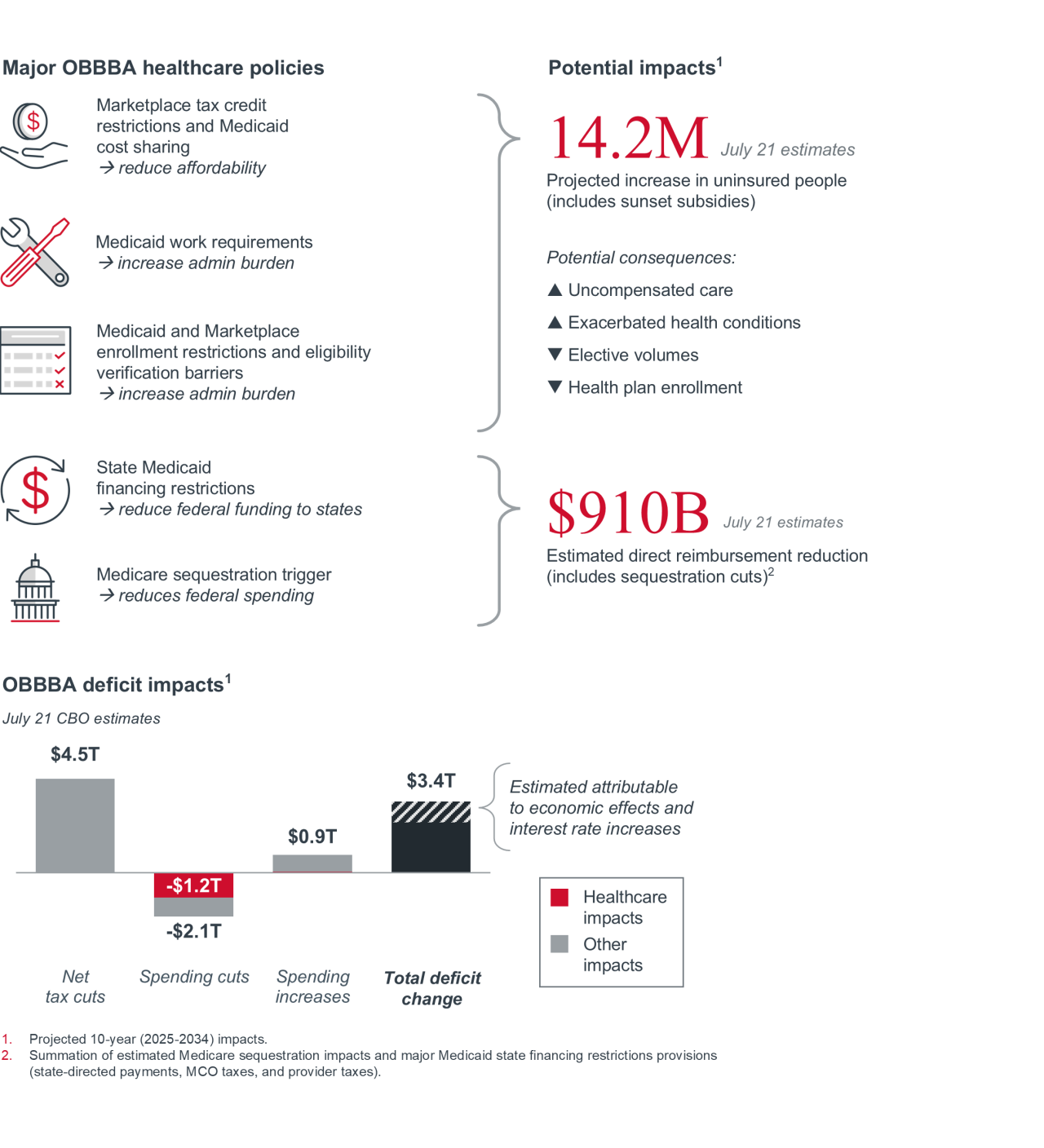
Reference sheet: Key OBBBA changes
Notable healthcare provisions in the One Big Beautiful Bill Act (OBBBA)
- Medicaid
- Medicare
- ACA Marketplace
- Other
- Implements Medicaid work requirements for adults ages 19 to 64 who don't have disabilities or dependents, with beneficiaries having to document at least 80 hours a month of work or other qualifying activities.
- Requires eligibility redeterminations every six months for adults who are covered under ACA Medicaid expansions.
- Mandates cost-sharing up to $35 per service for Medicaid expansion enrollees who have incomes above the federal poverty level.
- Bans Medicaid payments for healthcare provided to most lawfully present migrants, as well as emergency health services provided to most migrants in Medicaid expansion states.
- Prohibits healthcare providers from offering abortion services while receiving Medicaid payments.
- Bans new state provider taxes and reduces existing taxes from 6% of a provider's net patient revenue to 3.5% over several years.
- Requires states to conduct quarterly checks using the Death Master File to ensure that Medicaid enrollees are not deceased and must disenroll them if confirmed.
- Triggers Medicare cuts from the Statutory Pay-As-You-Go Act of 2010.
- Increases Medicare physician reimbursements by 2.5% in 2026.
- Allows $16 billion in cuts to Medicare disproportionate share hospital payments for three years (rather than deferring as previously done).
- Blocks a rule that eased eligibility in Medicare Savings Programs for people enrolled in both Medicare and Medicaid.
- Restricts most immigrants, including those who have received asylum, from receiving Medicare benefits.
- Requires states to ensure that deceased individuals are not receiving Medicare benefits.
- Modifies the Inflation Reduction Act's Medicare Drug Price Negotiation Program by broadening the exemption for orphan drugs, ensuring that more drugs designated for rare diseases are excluded from price negotiation if they meet certain criteria.
- Implements stricter eligibility and income verification requirements for people who receive ACA exchange subsidies as well as new checks for low-income enrollees who have zero-premium plans.
- Ends eligibility for premium tax credits for special enrollment periods.
- Ends ACA initiatives aimed at encouraging states to expand Medicaid.
- Prohibits premium tax credits from being provided to most migrants or enrollees whose status is in doubt.
- Notes that individuals who lose Medicaid coverage due to noncompliance with work requirements are still considered to have had minimum essential coverage for tax purposes, which could affect their eligibility for ACA subsidies.
- Ends auto-reenrollment and provisional enrollment for ACA plans starting in 2028.
- Requires pre-verification of eligibility before receiving advance premium tax credits (APTCs).
- Disallows APTCs for individuals who enroll through the monthly Special Enrollment Period for those with incomes less than or equal to 150% of the federal poverty level.
- Removes caps on recapture of excess APTCs for individuals under 400% of the federal poverty level.
- Treats Bronze and Catastrophic level ACA plans as high-deductible health plans starting in 2026.
- Includes a rural health fund, which will provide rural hospitals and community health centers with $50 billion over five years.
- Establishes a new program under the Children's Health Insurance Program to support rural hospitals and providers with funds that can be used for care coordination, telehealth, workforce development, and alternative payment models (note: this program is distinct from the rural health fund).
- Expands eligibility for health savings accounts and allows funds to be used to pay for direct primary care arrangements.
- Places a moratorium on a Biden-era regulation that set minimum staffing requirements for nursing homes.
- Permanently extends the safe harbor for high-deductible health plans to cover telehealth services pre-deductible.
OBBBA and its impact for hospitals at a glance
While some provisions of the One Big Beautiful Bill Act took effect immediately, many of the biggest healthcare cuts will take effect over time. Several major changes to enrollment, eligibility, and affordability will take effect in the next few years, while Medicaid payment cuts to states will phase in over time starting in several years. As states begin to implement the policies over the coming years, the impact to health system margins will compound — and intersect with other executive branch actions.
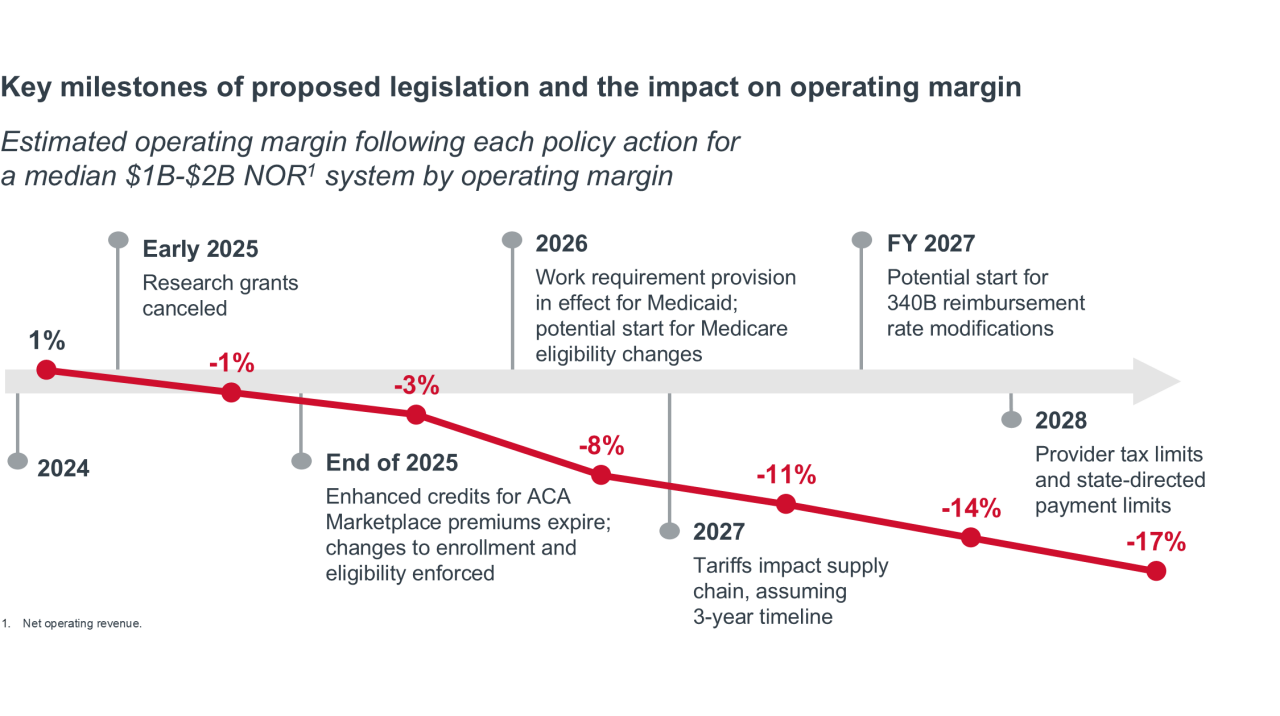
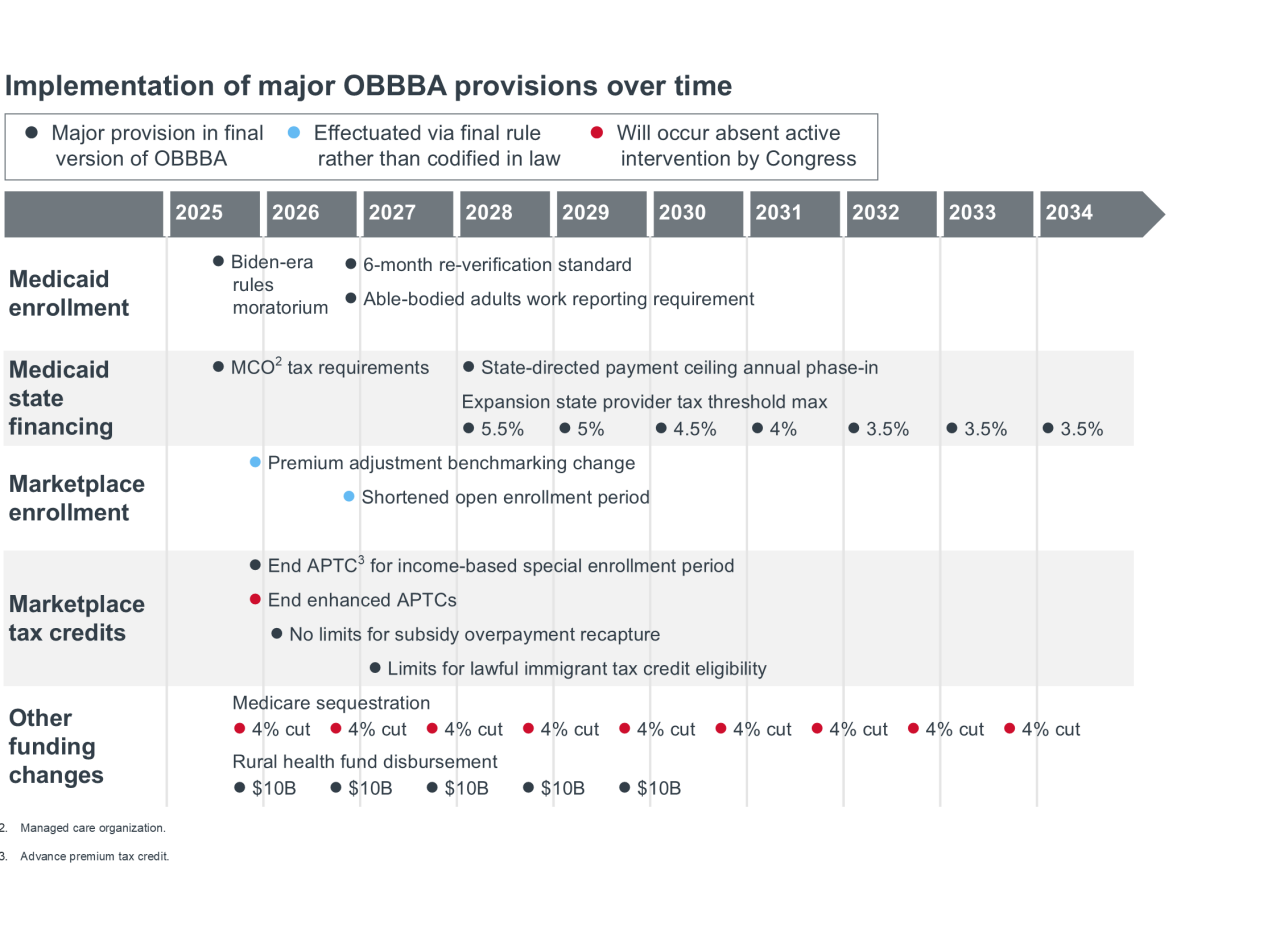
Future financial impacts of enacted policies
Policy changes could reduce health system margins by 8 to 18 points
Healthcare leaders need to assess the impact of a range of different policies (and their severity) on their organizations. Advisory Board’s data and analytics team has constructed a scenario planning model to estimate the impact of different policy drivers on hospitals and health systems of different sizes. We use data from Syntellis Market Insights to model the impact of scenarios on median operating margin.
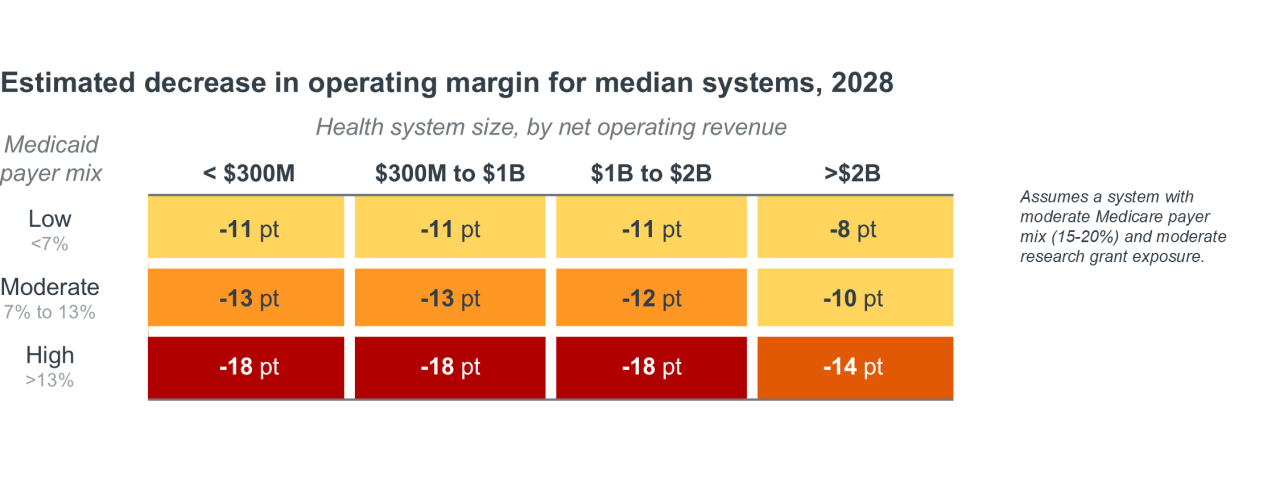
| Policy impacts | Scenario assumptions (7/9/25) |
| Medicaid cuts reduce volumes, reduce reimbursement rates, increase uncompensated care | Severe — work requirements, provider taxes restrictions, state-directed payments restrictions, enrollment and eligibility policies |
| Medicare cuts reduce reimbursement rates | Severe— 4% sequestration currently expected due to deficits |
| ACA cuts reduce volumes, increase uncompensated care | Severe — premium tax credit restrictions, enrollment and eligibility policies, premium payment policies |
| Tariffs increase input costs | Mild — 10% baseline tariff with select additional tariffs; other tariffs mostly delayed or threatened |
| Grant funding cuts reduce research and support services | Severe — major reductions in NIH and Department of Education funding in effect |
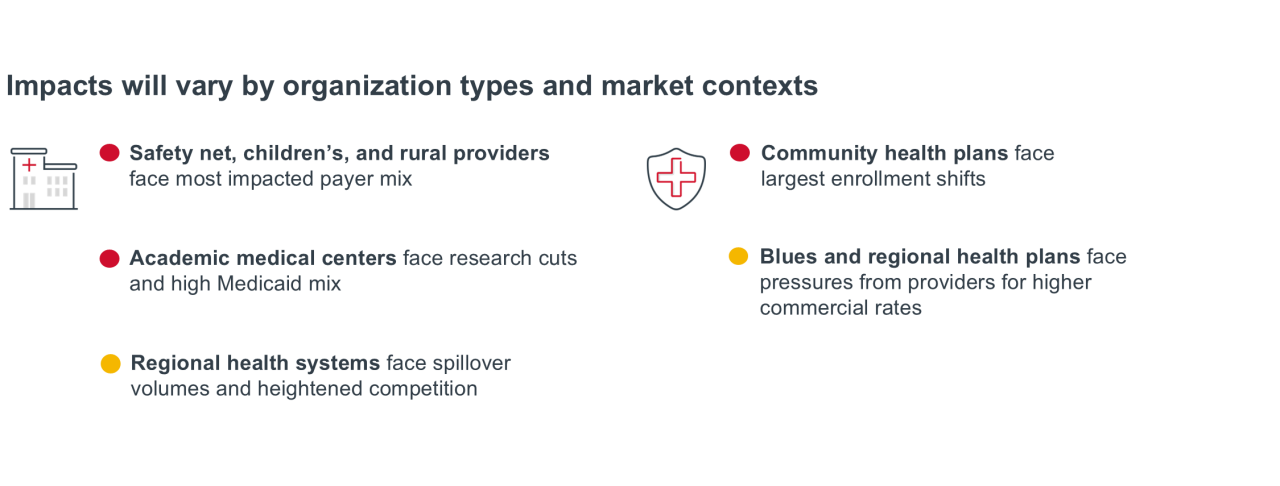
Other policy areas to watch
Site-neutral payments
Congress looking at for fall 2025; CMS proposed expansion
340B and drug pricing reform
Medicaid reductions could impact 340B designation; further state and federal drug pricing activity expected
Industry operating conditions driven by policy
OBBBA is a landmark overhaul amid a broader set of transformations
Healthcare leaders have described the One Big Beautiful Bill Act as the single biggest legislative disruption to the industry since the Balanced Budget Act of 1997 (BBA) — which at the time projected $390 billion1 in cuts to Medicare and Medicaid. While OBBBA is currently set to vastly exceed that, it is only a part of the transformation happening across the healthcare policy landscape today.
The second Trump administration has brought major changes across the federal government’s direct healthcare funding and regulatory activities, and across the general business environment more broadly. While many actions are still facing legal counteraction and potential pushback from Congress, the immediate changes — and the industry’s reactions — will shape the operating conditions for healthcare organizations for years to come..
Industry funding
Funding restrictions
(research funding cuts, coverage erosion)
Federal budget
(Medicaid, Medicare, and ACA funding cuts)
Business environment
Cost drivers
(tariffs, immigration)
Market regulation
(antitrust, pricing, transparency, Medicare Advantage risk adjustment)
Economic outlook
(inflation, employment, interest rates, credit stability)
Health regulation
DOGE2 & MAHA3
(layoffs, data redaction, program changes)
HHS operations
(restructuring, core program functions, care guidelines)
How the industry is preparing for policy change
Leaders across the healthcare industry are focused on steering their organizations through the financial strain and operational complexity ahead. Health systems must manage performance improvement across many frontiers at once, health plans must balance competing government and commercial pressures, and life sciences and technology firms must adapt to the spillover effects of their industry partners under threat.
Key priorities to prepare for policy changes, by healthcare sector
Hospitals and health systems
Capital and scenario planning
- Revisit strategic planning and impact analyses
- Rationalize services and infrastructure footprint
- Acquire hospitals and freestanding infrastructure
- Coordinate on rural and safety net support
Revenue loss mitigation strategy
- Improve revenue cycle performance
- Attract commercial volume growth
- Target service line growth investments
- Pursue VBC and alternative growth sources
Cost containment and efficiency
- Improve clinical operational efficiency
- Optimize supplies management and contracting
- Leverage tech for efficiency improvement
Workforce and access management
- Manage workforce capacity and retention
- Address access and preventive care gaps
- Leverage scale and partnerships
Health plans
- Minimize public insurance enrollment losses in partnership with state agencies
- Determine preventive coverage policies
- Negotiate commercial network rates that balance affordability and sustainability
Life sciences and technology firms
- Understand how policy impacts health system strategic planning
- Identify flexibilities for provider contracting to support cost reduction efforts
- Reassess portfolio and sales strategies
Advisory Board can help you…
UNDERSTAND the essentials of major policy shifts unfolding
Curated summary information to help your team digest the biggest changes and stay updated about unfolding developments.
Resource page
Healthcare policy updates timeline
Featuring relevant Daily Briefing and Radio Advisory excerpts
ESTIMATE the impact of regulatory changes on the health system business
Guidance and modeling tools to help you evaluate the potential business ramifications of provisions in OBBBA and other possible regulatory changes ahead.
Expert insight
How policy changes will impact your bottom line
ANTICIPATE how peers are grappling with the evolving policy forces
Candid perspectives from leaders at healthcare organizations across the nation about their challenges and priorities, and future opportunities to engage with peers.
Event
Peer executive discussion workshops
Contact ask@advisory.com
EXECUTE on strategic initiatives that are essential to sustain the business
Case study examples, strategic guidance, and prioritization resources to assist with growth planning, operational efficiency, workforce management, service line strategy, and more.
Best practices, strategic research, and Optum Advisory consulting support for:
- Strategic planning
- Service rationalization
- Supply chain optimization
- Revenue cycle integrity
- Workforce engagement
- Care team redesign
- Care variation reduction
- Patient throughput
- IT and automation optimization
Don't miss out on the latest Advisory Board insights
Create your free account to access 1 resource, including the latest research and webinars.
Want access without creating an account?
You have 1 free members-only resource remaining this month.
1 free members-only resources remaining
1 free members-only resources remaining
You've reached your limit of free insights
Become a member to access all of Advisory Board's resources, events, and experts
Never miss out on the latest innovative health care content tailored to you.
Benefits include:
You've reached your limit of free insights
Become a member to access all of Advisory Board's resources, events, and experts
Never miss out on the latest innovative health care content tailored to you.
Benefits include:
This content is available through your Curated Research partnership with Advisory Board. Click on ‘view this resource’ to read the full piece
Email ask@advisory.com to learn more
Click on ‘Become a Member’ to learn about the benefits of a Full-Access partnership with Advisory Board
Never miss out on the latest innovative health care content tailored to you.
Benefits Include:
This is for members only. Learn more.
Click on ‘Become a Member’ to learn about the benefits of a Full-Access partnership with Advisory Board
Never miss out on the latest innovative health care content tailored to you.





